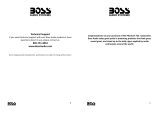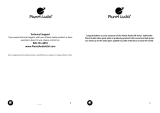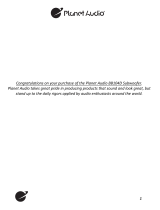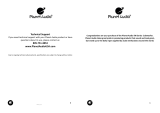
kappa series
102.7w,104.7w,
122.7w,124.7w
i
n
s
t
r
u
c
t
i
o
n
s
KAPPA SUB OM 1/24/06 11:32 AM Page 1

An optimum sealed enclosure for Kappa Series
subwoofers is always smaller than an optimum
enclosure of another type. We recommend sealed
enclosures for enthusiasts who prefer accurate
music reproduction and flat frequency response,
for those who have only a small space to devote
to a subwoofer enclosure or for those who have
plenty of amplifier power devoted to driving the
subwoofer.
Sealed-enclosure construction is straightforward
and forgiving of errors in volume calculation, but
air leaks should be avoided. Use medium-density
fiberboard (MDF), glue and screws to construct
the enclosure, and seal all joints with silicone
caulk.
VENTED ENCLOSURES
A vented enclosure acts like a sealed enclosure
at frequencies above the tuned (resonance)
frequency. At resonance, which is defined by
the vent, the woofer is nearly stationary while
the air inside the vent vibrates; the vent produces
the majority of sound. This condition provides
greater mec
hanical power handling at and
above resonance, but reduced mechanical power
handling below resonance. Since the woofer
doesn’t move much at resonance, airflow across
the voice coil is minimized and thermal power
handling is reduced slightly at resonance. Vented
enclosures provide better efficiency in the 40Hz –
60Hz range, at the expense of sound output in the
lowest octave (below 40Hz). We recommend the
use of a subsonic filter with vented enclosures.
An optimum vented enclosure for a Kappa Series
subwoofer is larger than an optimum sealed
enclosure. We recommend Infinity Kappa Series
woofers in vented enclosures for enthusiasts
who prefer accentuated bass response, for those
who have plenty of cargo space to devote to a
subwoofer enclosure and for those who will use a
less powerful amplifier to drive their subwoofers.
kappa series
THANK YOU for choosing an Infinity Kappa
®
Series subwoofer. Kappa Series subwoofers are
designed to suit a broad range of mobile audio
applications and can be used in a wide variety of
enclosure types to produce extended, powerful
bass in a limited amount of vehicle space. To
ensure maximum subwoofer performance, we
strongly recommend that installation be left to a
qualified professional. Although these instructions
explain how to install a Kappa Series subwoofer in
a general sense, they do not show box-construction
details and exact installation methods for your
particular vehicle. If you do not feel you have
the necessary experience, do not attempt the
installation yourself, but instead ask your
authorized Infinity car audio dealer about
professional installation options.
Remember to keep your sales receipt with this
manual in a safe place so both are available for
future reference.
LOUD MUSIC AND HEARING
Playing loud music in an automobile can hinder
your ability to hear traf
fic, as well as permanently
damage your hearing. The maximum volume
levels achievable with Infinity speakers, combined
with high power amplification, may exceed safe
levels for extended listening. We recommend
using low volume levels when driving. Infinity
accepts no liability for hearing loss, bodily injury,
or property damage as a result of use or misuse
of this product.
Kappa Series subwoofers are designed to
perform best in moderately sized sealed
enclosures, vented enclosures and prefabricated
bandpass enclosures. Infinite-baffle mounting
is possible, but mechanical power handling will
be reduced because there will be no volume
of air to stiffen the woofer’s suspension and
prevent overexcursion. If you choose infinite-
baffle mounting, consider the RMS and Peak
power handling ratings to be half of what is
printed in the specifications chart in this manual.
You should choose an enclosure type based on
the amount of cargo space you can devote to an
enclosure, the amount of power you will use to
drive your subwoofer(s), and your listening habits.
SEALED ENCLOSURES
The air trapped inside a sealed enclosure is
compressed when the woofer moves rearward
and is rarefied when the woofer moves forward.
In both cases, the air inside and outside the box
will seek equilibrium by pushing and pulling on
the woofer; the result is a stiffer suspension when
compared to the woofer alone. This means that
the woofer’s cone is harder to move at low
frequencies, a condition whic
h both protects
the woofer from overexcursion and uses more
power than other designs for the same acoustic
output. A sealed enclosure and your Kappa Series
subwoofer will provide the flattest overall
response and the widest bandwidth in the
car at the expense of overall efficiency. Kappa
woofers in sealed enclosures provide usable
response below 20Hz inside a vehicle. The sealed
enclosure design indicated on the Enclosure
Design Sheet which accompanies this manual
represents the best compromise between
low-frequency extension and flat response.
Vented-enclosure construction is more difficult
than the construction of a sealed enclosure. The
enclosure volume and port dimensions have a
specific relationship with the characteristics of the
subwoofer, so the volume and port dimensions
indicated on the included Enclosure Design Sheet
must be followed precisely to ensure optimum
performance. As with sealed enclosures, use
medium-density fiberboard (MDF), glue and
screws to construct the enclosure, and seal all
joints with silicone caulk.
BANDPASS ENCLOSURES
Bandpass enclosures can provide the most output
from any amplifier and woofer combination over
a limited band of frequencies, but that additional
output comes at the expense of sonic accuracy.
If the highest sound-pressure level (SPL) is your
ONLY design goal, choose a bandpass enclosure.
The bandpass enclosure found on the included
Enclosure Design Sheet is a combination of a
sealed enclosure and a vented enclosure. The
sealed enclosure stiffens the suspension of
the woofer, just as it does in a simple sealed
enclosure, and the vented enclosure into which
the woofer outputs sound provides an acoustic
low-pass filter which attenuates high frequencies
in the woofer’s output. That attenuation of high
frequencies can make it very difficult to hear
amplifier and speaker distortion; consequently,
you may not be able to determine when the
subwoofer is in danger of being damaged.
An optimum bandpass enclosure is often
larger than an optimum vented enclosure.
We recommend bandpass enclosures only
for enthusiasts who want high SPL without
regard for sonic accuracy. If high SPL is your
goal AND you care about great-sounding
bass, choose a vented enclosure instead.
INSTALLATION WARNINGS AND TIPS
CHOOSING AN ENCLOSURE
KAPPA SUB OM 1/24/06 11:32 AM Page 2

kappa series
Bandpass-enclosure construction is more difficult
than vented box construction and, as with vented
enclosures, the design parameters for the vented
section must be followed carefully. Small errors in
calculating the volume of and building the sealed
section won’t drastically alter the result. Fortunately,
there are many prefabricated bandpass enclosures
that are designed to extract the most output possi-
ble from nearly any woofer. We recommend these if
you must have a bandpass enclosure. If you choose
to build your own bandpass enclosure, use MDF,
glue and screws to construct the enclosure, and be
sure to seal all joints with silicone caulk.
YOUR CAR AND BASS REPRODUCTION
Depending on the size of your vehicle’s interior
listening space, reproduced bass frequencies
below about 70Hz are boosted by nearly 12dB
per octave as frequency decreases. This is because
the interior of the car is a lossy sealed enclosure
and the pressure increase is proportionate to
the woofer’s excursion, which increases with
decreasing input frequency.
That phenomenon, known as the vehicle’s transfer
function or cabin gain, plays an important role in
shaping the frequency response of the woofer in
the car, and is displayed graphically alongside the
out-of-car response on the included Enclosure
Design Sheet for your Kappa subwoofer.
You may notice that the amount of bass increases
when you open any of the windows or the trunk
of the car, and decreases when you close any of
those openings. This is not a function of your
enclosure; rather, the opening of the window or
trunk turns the lossy sealed enclosure in which you
listen (the car’s interior) into a vented enclosure.
The air in the open window or trunk vibrates,
just as the air trapped inside an enclosure’s vent
vibrates. That vibration increases the system’s
output at the resonance frequency, defined by
the volume of air in the listening area and the
dimensions of the vent (open window or trunk).
For many cars, that frequency is roughly 40Hz.
Kappa Series subwoofers include an impedance
selection switch, which will allow you to choose
between 1 and 4 ohms for 102.7w and 122.7w,
and between 2 and 8 ohms for 104.7w and
124.7w. If you are using multiple woofers
connected in either series or parallel in a single
system, be sure that the impedance selection
switch is in the same position for all woofers in
the system. That will ensure that each woofer is
driven with the same amount of power.
Figure 1. Impedance selector switch
102.7w 104.7w
PO
WER CONSIDERATIONS
To design a subwoofer system that maximizes
available amplifier power, keep the following
rules in mind:
The formula for total system impedance for
woofers connected in parallel is:
I=1/(1/w
1
+1/w
2
+1/w
3
…)
And the formula for total system impedance for
woofers connected in series is:
I= w
1
+w
2
+w
3
…
(w= impedance of any individual woofer)
For several woofers connected in series-parallel,
use both formulae to determine the final system
impedance.
The following table can serve as a reference for
often-used combinations:
woofer number final
impedance of connection impedance
(ohms)
woofers scheme (ohms)
1 2 parallel 0.5
1 3 parallel 0.33
1 4 series-parallel 1
1 2 series 2
1 3 series 3
1 4 series 4
2 2 parallel 1
2 3 parallel 0.66
2 4 series-parallel 2
2 2 series 4
2 3 series 6
2 4 series 8
4 2 parallel 2
4 3 parallel 1.33
4 4 parallel 1
4 4 series-parallel 4
4 2 series 8
8 2 parallel
4
8 3 parallel 2.66
8 4 parallel 2
The following illustrations show parallel and
series connections of Kappa woofers.
Figure 2. Parallel connection
Figure 3. Series connection
Figure 4. Four woofers connected in series-parallel
CONNECTIONSCHOOSING AN ENCLOSURE (CONT.)
KAPPA SUB OM 1/24/06 11:32 AM Page 3

Declaration of Conformity
We, Harman Consumer Group International
2, route de Tours
72500 Château du Loir
France
declare in own responsibility that the products
described in this owner
’s manual are in compliance
with technical standards:
EN 61000-6-3:2001
EN 61000-6-1:2001
Klaus Lebherz
Harman Consumer Group International
Château du Loir, France 1/06
A valid serial number is required for warranty coverage.
This product is designed for mobile applications and is not intended for connection to the mains.
Features, specifications and appearance are subject to change without notice.
Infinity, Harman International and Kappa are trademarks of Harman International Industries, Incorporated,
registered in the United States and/or other countries.
102.7w
Type: 10" Subwoofer,
dual-voice coil
Nominal Impedance: 1 ohm or 4 ohms
Power Handling: 350W RMS, 1400W Peak
Sensitivity (2.83V, 1m): 89dB
Frequency Response: 20Hz – 250Hz
Mounting Depth: 4-3/4" (121mm)
Cutout Diameter: 9-1/8" (232mm)
104.7w
Type: 10" Subwoofer,
dual-voice coil
Nominal Impedance: 2 or 8 ohms
Power Handling: 350W RMS, 1400W Peak
Sensitivity (2.83V, 1m): 87dB
Frequency Response: 20Hz – 250Hz
Mounting Depth: 4-3/4" (121mm)
Cutout Diameter: 9-1/8" (232mm)
122.7w
Type: 12" Subwoofer,
dual-voice coil
Nominal Impedance: 1 ohm or 4 ohms
Power Handling: 350W RMS, 1400W Peak
Sensitivity (2.83V, 1m): 92dB
Frequency Response: 18Hz – 250Hz
Mounting Depth: 5" (127mm)
Cutout Diameter: 11-1/8" (283mm)
124.7w
Type: 12" Subwoofer,
dual-voice coil
Nominal Impedance: 2 or 8 ohms
Power Handling: 350W RMS, 1400W Peak
Sensitivity (2.83V, 1m): 90dB
Frequency Response: 18Hz – 250Hz
Mounting Depth: 5" (127mm)
Cutout Diameter: 11-1/8" (283mm)
SPECIFICATIONS
¤
Infinity Systems, 250 Crossways Park Drive, Woodbury, NY 11797 USA
516.674.4463 • FAX 516.682.3523 • www.infinitysystems.com
© 2006 Harman International Industries, Incorporated. All rights reserved. • Part No. KAPSUBOM1/06
KAPPA SUB OM 1/24/06 11:32 AM Page 4
-
 1
1
-
 2
2
-
 3
3
-
 4
4
Infinity Kappa Series 102.7w User manual
- Type
- User manual
- This manual is also suitable for
Ask a question and I''ll find the answer in the document
Finding information in a document is now easier with AI
Related papers
-
Infinity KAPPA ONE Owner's manual
-
Infinity Kappa perfect 12d VQ User manual
-
Harman Kardon Speaker 100.3SE User manual
-
Infinity kappa 100.3dvc Operating instructions
-
Infinity 100.1dvc User manual
-
Infinity Kappa Series KAPPA ONE User manual
-
Infinity Kappa 120.9w User manual
-
Infinity 62m User manual
-
Infinity Kappa 1200W Owner's manual
-
Infinity KAPPA series Owner's manual
Other documents
-
MB QUART RLP304 Owner's manual
-
JBL CS1204 Owner's manual
-
SSL GSW12D 12 User manual
-
a/d/s/ 310rs Installation guide
-
 Boss Audio Systems P120F User manual
Boss Audio Systems P120F User manual
-
JBL GT5-15 Owner's manual
-
 Planet Aaudio SW12DEN User manual
Planet Aaudio SW12DEN User manual
-
JBL GT5-10 Owner's manual
-
 Planet Audio BB104D User manual
Planet Audio BB104D User manual
-
 Planet Aaudio SW10D User manual
Planet Aaudio SW10D User manual







